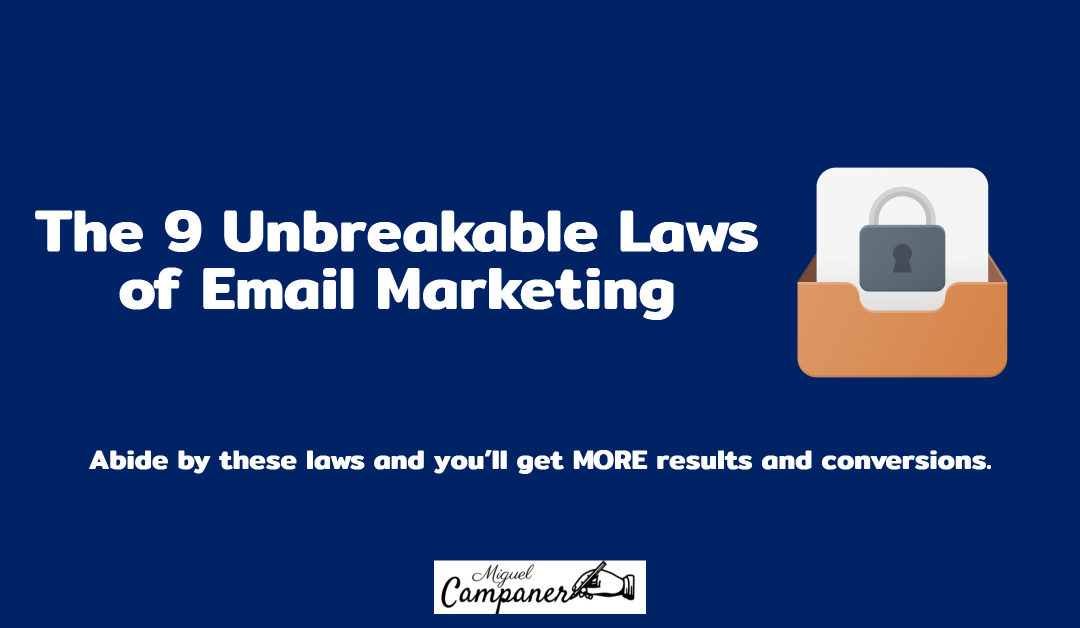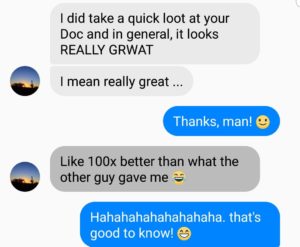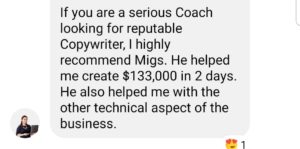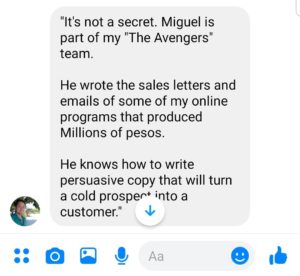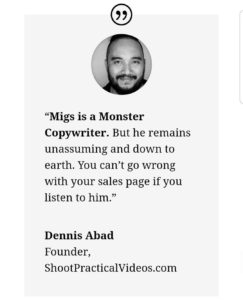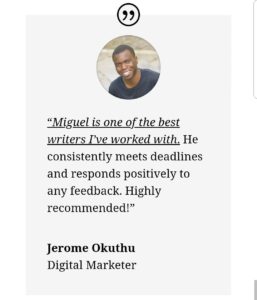Whether you believe this or not…
Email is the most profitable marketing channel in the past 20 years.
Email provides better ROI than TV advertising, Pay-Per-Click, Radio Advertising, Billboard Ads, Messenger Marketing, Social Media, and even Direct Mail.
According to a recent study by Campaign Monitor, the average business earns $44 for every $1 spent in email marketing.
You can’t do the same for other types of marketing channels.
That’s why, in today’s digital marketing landscape, email copywriting and email marketing RULES.

I’m not saying that you won’t be profitable if you don’t have an email marketing strategy in place.
What I’m simply saying is this:
If you’re not using email, you’re missing out on a lot of sales.
Since you’re reading this, you’re either…
- Not sure you’re making the most out of your emails
- OR, you’re just starting to build an email list and execute and email marketing strategy
Whether you’re #1 or #2, this post was written specifically for you.
For the past few years, I’ve written thousands of emails for sales funnels.
Based on my experience (and spending a lot of money on coaching and courses), I discovered 9 Laws you shouldn’t break…ever.
If you do, your emails and overall email marketing strategy won’t be as effective.
What are these laws?
Well, here they are…
1. Your Name > Subject Line
The first thing your prospect sees is your NAME. Not the subject line. That’s why your name holds more weight.
Think about it.
Before email marketing was born…
We only read emails from people we know, like, and trust…right?
If we don’t recognize the name, we delete it. We think it’s spam.
The same is true today.
If you want to stay in your prospects’ inbox, they must know, like and trust you.
Because even if your subject lines are full of curiosity, benefit, and desire, they won’t open it.
That’s why you should build KLT in your first 5 emails. Your welcome email sequence and indoctrination sequence MUST be on point.
Otherwise, you’ll just be one of the 200 emails they won’t open.
2. Value = Opens
Your emails must provide value. It shouldn’t be an endless pitch fest.
Once they equate value to your name, your subscribers will constantly open your emails.
Aside from an obvious uptick in sales, you won’t have to worry about when to send emails anymore. It won’t matter because prospects will read them even if they missed your scheduled broadcasts.
Now, with that said, you actually know how to provide value to your prospects?
You see, I’ve worked with dozens of online businesses. And the #1 reason why business owners aren’t as successful as they want to is because of this issue — they don’t know what’s “valuable” to their client.
You can easily eliminate this problem by doing in-depth research. You can conduct interviews or execute the ASK method.
The more you know about your prospects… the more you can add value into their lives… the more your sales will increase.
This isn’t speculation. It’s a proven fact.
So in a nutshell, provide value. Don’t always pitch.
If you don’t know how to provide value, do research.
3. Tell Stories
Another way you can provide value is by entertaining them. One of the best ways to entertain is to tell stories.
The story can be yours. It can be a historical fact. It can even be a story you heard somewhere.
You can also use a testimonial as a story. Demonstrate to your subscribers how your product/service solved problems.
As long as you make it interesting and there’s a lesson behind it, you’re gold.
Stories are powerful sales tools as well. They’re not just tools to entertain.
Remember the OJ Simpson trial? The defense (OJ Simpson’s lawyers) told a better story than the prosecution. Their story was the evidence was planted by racist cops.
In the end, their story triggered an emotional response. The jury gave a “not guilty” verdict because their story made “more sense” compared to the Prosecution’s story.
Whether you sell info products, retail products, or even groceries…
Tell stories in your emails.
4. Pre-Frame
Not everyone is ready to buy. In any given list, only a few subscribers buy on the first email.
Most subscribers need more time to see if your offers are as good as you say they are.
That’s why we “pre-frame” them so they arrive to that decision faster.
So….
How exactly do you pre-frame subscribers?
First, you have to understand the five levels of awareness. Most subscribers enter your email list as Problem Aware.
You want to move them from Problem Aware to Solution Aware to Product Aware. You can do this by sharing stories, breaking beliefs, addressing skepticism, and so much more. It depends from market to market.
Once your subscribers become “Product Aware”, that’s when you pitch your offers.
If you pre-framed them well, you won’t experience much sales resistance.
5. Sell the Click
In most cases, you persuade subscribers to click the link to your sales page. So you’re not persuading subscribers to buy yet. You’re persuading them to click and read what’s on the next page.
Most copywriters and marketers forget that.
In your emails, you’re not selling the product…yet. You’re selling the click. What you want them to do is make a “micro commitment” because this will lead to another micro commitment. The next thing you know, prospects are fully committed to whatever you want them to do.
That’s why focus on selling the click first. The sales, results, and conversions will follow.
6. Write to only 1 person
When you’re writing to everyone, trying to make everyone feel “included”, you’re writing to no one.
No one will resonate with whatever you’re saying.
I mean, have you tried writing a single-page letter to your father, mother, and siblings? One letter to everyone you love? No, right?
You write one letter for each member. If not, your message might get mixed. The paragraph meant you want to tell things only your brother can understand. And there are things you only want to tell your parents.
It’s the same way with emails.
When you write an email, make sure it’s for one specific person. Your sales message will be understood. There will be no confusion. Most importantly, it will connect better.
Remember, if you write to everyone, you’ll be reaching no one.
Write to one specific person per email.
7. Demonstrate. Don’t Teach
Gary Bencivenga, one of the greatest copywriters who ever lived, said that demonstration is proof. If you know how to demonstrate, you won’t need testimonials or research to back up your claims.
You simply need to demonstrate what you know.
Of course, it needs to be the right demonstration to the right person at the right time.
Luckily for you, you have many times to demonstrate with email.
In your emails, you can demonstrate by teaching lessons, sharing a story, or a cautionary tale. Even a small anecdote of your life can turn into a demonstration.
That’s what Andre Chaperon and Ben Settle have been doing for years. They demonstrate their copywriting prowess by sharing fun stories, hard-won lessons, and even how they fight the occasional trolls.
8. Curiosity is key
If you can trigger curiosity, you will win the inbox. If you win the inbox, you’ll get email opens, clicks, and eventually conversions.
The best way to trigger curiosity is to create a gap in the subject line. You can lead with a cliffhanger, a hint at a lesson, or share an amazing story. Whatever it is, it must create an itch. An itch they can only scratch when they open the email.
Here are a few subject line examples I’ve seen in the wild…
✏️ Crouching marketer, hidden copywriter
✏️ Can I interview you?
✏️ So I fought a Martian today
✏️ From $15K to $50K/mo as a copywriter
✏️ I’d like to apologize
But your job doesn’t stop there.
There must be a satisfying pay-off. Their curiosity must be rewarded. If not, they’ll feel cheated. And you never want your subscribers feel cheated…
…or any kind of emotion towards you.
Write subject lines you can back up. Otherwise, you’ll be known as one of those email copywriters who writes clickbaits — all flash, no substance.
9. Write the way you speak
When somebody says “be yourself” in your emails…
…most of the time, this is what they’re saying. Don’t try to copy someone else. Don’t try to be another person.
Write the way you speak. Write what comes naturally to you.
If you always say “gonna” instead of “going to,” then type that. If you prefer saying “lil” instead of “little,” go ahead.
This will make writing easier…maybe even enjoyable.
PLUS, it will make your emails effortlessly conversational and have personality — this is what’s missing with most email marketing campaigns today.
Look…
Your subscribers want to receive emails from another human being…not a perfect, grammatically robot with zero personality.
So be confident. Find your writing voice. Write how you speak. You’ll be surprised how many people will LOVE you for it and will BUY because of this.
Recap: Here are the 9 Unbreakable Laws of Email Marketing…
🔗 Sender’s Name is more important than the Subject Line
🔗 Your emails must add value into your subscribers’ lives
🔗 Tell stories in your emails
🔗 Your emails must pre-frame subscribers
🔗 You sell the click. Not the product.
🔗 Write to only 1 person
🔗 Demonstrate. Don’t Teach.
🔗 Curiosity is Key
🔗 Write the way you speak.
Abide by these laws and I’m certain you’ll get MORE results and conversions.
By simply applying #4 and #7, you can immediately see an uptick in sales.
If you already have an email list and need someone to help you apply these, book a 30-minute consultation.
If you have a proven offer with more than 100 customers, I’ll design an entire marketing that’ll generate an extra 5- or 6-figures in sales.
Once I start, all you have to do is wait.
I do the work. You make the money.
If that sounds good to you, book a 30-minute consultation.

